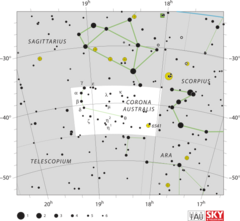Astronomy:Alpha Coronae Australis
| Observation data Equinox J2000.0]] (ICRS) | |
|---|---|
| Constellation | Corona Australis |
| Right ascension | 19h 09m 28.34097s[1] |
| Declination | –37° 54′ 16.1022″[1] |
| Apparent magnitude (V) | 4.102[2] |
| Characteristics | |
| Spectral type | A2V[3] |
| U−B color index | +0.06[4] |
| B−V color index | +0.04[4] |
| Astrometry | |
| Radial velocity (Rv) | −18.40±1.78[5] km/s |
| Proper motion (μ) | RA: 84.87[1] mas/yr Dec.: −95.99[1] mas/yr |
| Parallax (π) | 26.02 ± 0.25[1] mas |
| Distance | 125 ± 1 ly (38.4 ± 0.4 pc) |
| Absolute magnitude (MV) | 1.11[6] |
| Details | |
| Mass | 2.57[7] M☉ |
| Radius | 2.21[3] R☉ |
| Luminosity | 31[8] L☉ |
| Surface gravity (log g) | 4.08[7] cgs |
| Temperature | 9,916±337[7] K |
| Rotational velocity (v sin i) | 195[9] km/s |
| Age | 254[2] Myr |
| Other designations | |
| Database references | |
| SIMBAD | data |
Alpha Coronae Australis or α Coronae Australis, officially named Meridiana (/məˌrɪdiˈænə/),[10] is the brightest star in the constellation of Corona Australis and is located about 125 light-years from Earth.
Nomenclature
α Coronae Australis (Latinised to Alpha Coronae Australis) is the star's Bayer designation.
It is the only star in the constellation with a traditional proper name, Alphekka Meridiana (Latin for 'Alphekka South'), after Alphecca, the brightest star in the constellation Corona Borealis.[citation needed] The name Alphecca or Alphekka is Arabic, short for نير الفكّة nayyir al-fakka "the bright (star) of the broken (ring of stars)".[11] In 2016, the IAU organized a Working Group on Star Names (WGSN)[12] to catalog and standardize proper names for stars. The WGSN approved the name Meridiana for this star on 5 September 2017 and it is now so included in the List of IAU-approved Star Names.[10]
In Chinese, 鱉 (Biē), meaning River Turtle, refers to an asterism consisting of Alpha Coronae Australis, Alpha Telescopii, Eta1 Coronae Australis, Zeta Coronae Australis, Delta Coronae Australis, Beta Coronae Australis, Gamma Coronae Australis, Epsilon Coronae Australis, HD 175362, Kappa2 Coronae Australis and Theta Coronae Australis.[13] Consequently, the Chinese name for Alpha Coronae Australis itself is 鱉六 (Biēliù, English: the Sixth Star of River Turtle.).[14]
Properties
Alpha Coronae Australis belongs to the spectral class A2Va, making it an A-type star like Vega. Like the latter, it has excess infrared radiation, which indicates it may be ringed by a disk of dust.[8] It has an apparent magnitude of +4.10.[4] The star's mass and radius are estimated at 2.3 times the Sun's mass and radius. With an effective temperature of roughly 9,100 K, the star radiates a total luminosity of about 31 times the Sun's.[8] This star is roughly 254 million years old.[2] A rapidly rotating star, it spins at almost 200 km per second at the equator, making a complete revolution in approximately 14 hours,[9] close to its breakup velocity.
See also
- Lists of stars in the constellation Corona Australis
- Class A Stars
- Vega
- Circumstellar disk
References
- ↑ 1.0 1.1 1.2 1.3 1.4 van Leeuwen, F. (November 2007). "Validation of the new Hipparcos reduction". Astronomy and Astrophysics 474 (2): 653–664. doi:10.1051/0004-6361:20078357. Bibcode: 2007A&A...474..653V.
- ↑ 2.0 2.1 2.2
- ↑ 3.0 3.1 Cotten, Tara H.; Song, Inseok (July 2016). "A Comprehensive Census of Nearby Infrared Excess Stars". The Astrophysical Journal Supplement Series 225 (1): 24. doi:10.3847/0067-0049/225/1/15. 15. Bibcode: 2016ApJS..225...15C.
- ↑ 4.0 4.1 4.2 4.3 "* alf CrA". SIMBAD. Centre de données astronomiques de Strasbourg. http://simbad.u-strasbg.fr/simbad/sim-basic?Ident=%2A+alf+CrA.
- ↑ Kharchenko, N. V. et al. (2007). "Astrophysical supplements to the ASCC-2.5: Ia. Radial velocities of ~55000 stars and mean radial velocities of 516 Galactic open clusters and associations". Astronomische Nachrichten 328 (9): 889. doi:10.1002/asna.200710776. Bibcode: 2007AN....328..889K.
- ↑ "α Coronae Australis (star)". Wolfram Alpha. http://www.wolframalpha.com/input/?i=alpha+coronae+australis.
- ↑ 7.0 7.1 7.2 David, Trevor J.; Hillenbrand, Lynne A. (2015). "The Ages of Early-Type Stars: Strömgren Photometric Methods Calibrated, Validated, Tested, and Applied to Hosts and Prospective Hosts of Directly Imaged Exoplanets". The Astrophysical Journal 804 (2): 146. doi:10.1088/0004-637X/804/2/146. Bibcode: 2015ApJ...804..146D.
- ↑ 8.0 8.1 8.2 Kaler, James B.. "ALFECCA MERIDIANA (Alpha Coronae Australis)". Stars. University of Illinois. http://stars.astro.illinois.edu/sow/alfecca.html.
- ↑ 9.0 9.1 Royer, F.; Zorec, J.; Gómez, A. E. (February 2007). "Rotational velocities of A-type stars. III. Velocity distributions". Astronomy and Astrophysics 463 (2): 671–682. doi:10.1051/0004-6361:20065224. Bibcode: 2007A&A...463..671R.
- ↑ 10.0 10.1 "Naming Stars". IAU.org. https://www.iau.org/public/themes/naming_stars/.
- ↑ Allen, Richard Hinckley (1963). Star Names: Their Lore and Meaning (Reprint ed.). New York City , NY: Dover Publications Inc.. pp. 172–73. ISBN 0-486-21079-0. https://archive.org/details/starnamestheirlo00alle/page/172.
- ↑ "IAU Working Group on Star Names (WGSN)". https://www.iau.org/science/scientific_bodies/working_groups/280/.
- ↑ (in Chinese) 中國星座神話, written by 陳久金. Published by 台灣書房出版有限公司, 2005, ISBN:978-986-7332-25-7.
- ↑ (in Chinese) 香港太空館 - 研究資源 - 亮星中英對照表 , Hong Kong Space Museum. Accessed on line November 23, 2010.
 |


